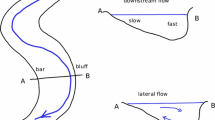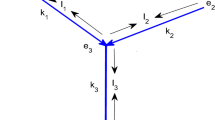Abstract
The balance between births and deaths in an age-structured population is strongly influenced by the spatial distribution of sub-populations. Our aim was to describe the demographic process of a fish population in an hierarchical dendritic river network, by taking into account the possible movements of individuals. We tried also to quantify the effect of river network changes (damming or channelling) on the global fish population dynamics. The Salmo trutta life pattern was taken as an example for.
We proposed a model which includes the demographic and the migration processes, considering migration fast compared to demography. The population was divided into three age-classes and subdivided into fifteen spatial patches, thus having 45 state variables. Both processes were described by means of constant transfer coefficients, so we were dealing with a linear system of difference equations. The discrete case of the variable aggregation method allowed the study of the system through the dominant elements of a much simpler linear system with only three global variables: the total number of individuals in each age-class.
From biological hypothesis on demographic and migratory parameters, we showed that the global population dynamics of fishes is well characterized in the reference river network, and that dams could have stronger effects on the global dynamics than channelling.
Similar content being viewed by others
REFERENCES
Auger, P. (1989). Dynamics and Thermodynamics in Hierarchically Organized Systems. Applications in Physics, Biology and Economics. Oxford, Pergamon Press.
Auger, P. and E. Benoît (1993). A prey-predator model in a multipatch environment with different time scales. Journal of Biological Systems 1: 187–197.
Auger, P. and J.C. Poggiale (1995). Emerging properties in population dynamics with different time scales. Journal of Biological Systems 3: 591–602.
Auger, P. and J.C. Poggiale (1996a). Aggregation and Emergence in hierarchically organized systems: population dynamics. Acta Biotheoretica 44: 301–316.
Auger, P. and J.C. Poggiale (1996b). Emergence of population growth models: fast migration and slow growth. Journal of Theoretical Biology 182: 99–108.
Auger, P.M. and R. Roussarie (1994) Complex ecological models with simple dynamics: from individuals to populations. Acta Biotheoretica 42: 111–136.
Baglinière, J.L. and G. Maisse (1991). Biologie de la truite commune (Salmo trutta L.) dans les rivières françaises. In: J.L. Baglinière and G. Maisse, eds., La Truite, Biologie et Écologie, pp 25–45. INRA Editions.
Bravo de la Parra, R., E. Sanchez and P. Auger (1995). Aggregation methods in discrete models. Journal of biological Systems 3: 603–612.
Bravo de la Parra, R., E. Sanchez and P. Auger (1997). Time scales in density dependent discrete models. Journal of biological Systems 5: 111–129.
Caswell, H. (1989). Matrix Population Models. Sunderland, Sinauer Associates Inc.
Crisp, D.T. (1993). Population densities of juvenile trout (Salmo trutta) in five upland streams and their effects upon growth, survival and dispersal. Journal of Applied Ecology 30: 759–771.
Cummins, K.W. (1979). The natural stream ecosystem. In: J.V. Ward and J.A. Stanford, eds., The Ecology of Regulated Stream, 398p. New York, Plenum Press.
Debowski, P. (1991). Density and mortality of Brown trout (Salmo trutta morpha fario L.) in two tributaries of the Pasleka River. Polskie Archiwum Hydrobiologii 38: 265–281.
Gard, T.C. (1988). Aggregation in stochastic ecosystem models. Ecological Modelling 4: 153–164.
Gardner, R.H., W.G. Cale and R.V. O'Neill (1982). Robust analysis of aggregation error. Ecology 63: 1771–1779.
Iwasa, Y., V. Andreasen and S.A. Levin (1987). Aggregation in model ecosystems. I. Perfect aggregation. Ecological Modelling 37: 287–302.
Iwasa, Y., S.A Levin and V. Andreasen (1989). Aggregation in model ecosystems II. Approximate aggregation. IMA J. Math. Appl. Med. Biol. 6: 1–23.
Levin, S.A. (1989). Challenges in the development of a theory of community and ecosystem structure and function. In: J. Roughgarden, R.M. May and S.A. Levin, eds., Perspectives in Ecological Theory, pp. 242–255. Princeton, Princeton University Press.
May, R.M. (1989). Levels of organization in ecology. In: Ecological Concepts. The Contribution of Ecology to an Understanding of the Natural World. BES Symposium, pp 339–363. Oxford, Blackwell Scientific Publications.
Michalsky, J., J.C. Poggiale, R. Arditi and P. Auger (1997). Macroscopic dynamic effects of migrations in patchy predator-prey systems. Journal of Theoretical Biology 185: 459–474.
Newman, R.M. (1993). A conceptual model for examining density dependence in the growth of stream trout. Ecology of Freshwater Fish 2: 121–131.
O'Neill, R.V., D.L. De Angelis, J.B. Waide and T.F.H. Allen (1986). A Hierarchical Concept of Ecosystems. Princeton, Princeton University Press.
Poggiale, J.C and P. Auger (1996). Fast oscillating migrations in a predator-prey model. Mathematical Models and Methods in Applied Sciences 6: 217–226.
Sanchez, E., R. Bravo de la Parra and P. Auger (1995). Linear discrete models with different time scales. Acta Biotheoretica 43: 465–479.
Author information
Authors and Affiliations
Rights and permissions
About this article
Cite this article
Charles, S., de la Parra, R.B., Mallet, J. et al. Population Dynamics Modelling in an Hierarchical Arborescent River Network: An Attempt with Salmo trutta. Acta Biotheor 46, 223–234 (1998). https://doi.org/10.1023/A:1001785110237
Issue Date:
DOI: https://doi.org/10.1023/A:1001785110237




